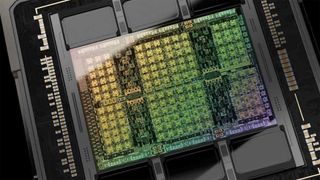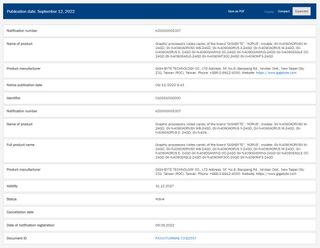Alleged Nvidia RTX 4090 Cards Appear in EEC Listing
A hint of what is to come?

An EEC listing - a list of products proposed for sale in the Eurasian Economic Commission area - Armenia, Belarus, Kazakhstan, Kyrgyzstan and Russia - has appeared detailing potential Gigabyte Nvidia GPUs, all of them 4090 models.

These listings appear from time to time, and aren’t to be taken as a definitive list of what Gigabyte intends to sell in a region. These listings are more Gigabyte covering its bases now so it doesn’t have to fill in additional paperwork later, as listing your products is a requirement in the EEA before selling them. Still, it gives us a vague idea of the shape an upcoming wave of top-end cards from one manufacturer might look like.
Many of the cards are using the Aorus sub-brand that Gigabyte uses for its high-performance components. Interestingly the number 24 appears in every single one of the 11 model numbers in the listing, so this could be a strong hint at the amount of included VRAM. This is the same as many 3090 and 3090Ti Ampere cards, as well as the Titan RTX from the Turing generation. The incoming Lovelace card can almost certainly be relied upon to use faster GDDR memory, or increase the memory bandwidth over the previous generation in some way, however.
Otherwise, the model names differ by sub-brand, with Gaming and Eagle also appearing, but not Xtreme, Elite, Turbo or Master as we saw in the 30-series cards. The letters prefixing the number 24 do perhaps give a clue, however, as they’re W, WB, X, M, E, OC (Gigabyte’s 3080 OC model ran just 45 MHz faster than the reference card), and WF3 (strongly pointing to a triple-fan Windforce model). Read into that what you will. The EEC filing is valid until 2027, so it’s possible some of these cards, if they appear at all, may appear later in the release cycle.
Gigabyte produced a chunky-looking RTX 3080 Eagle card with triple-fan Windforce cooling in the current generation, and we hope to see this level of design again - there's no reason graphics cards have to be simple black rectangles. We also saw built-in screens and watercooling from Gigabyte this gen, and while there's no reason to suspect these cards aren’t coming, they’re not specifically mentioned here - nor are the letters ‘RTX’, but we shouldn’t take this as a sign Nvidia has given up on ray-tracing.
With Russia and Kazakhstan under its purview, the EEC covers a huge area of land that’s not spectacularly densely populated. It may not, therefore, get the same number of cards as higher-volume markets such as the US. The listing gives no information about release dates or pricing.
Stay On the Cutting Edge: Get the Tom's Hardware Newsletter
Get Tom's Hardware's best news and in-depth reviews, straight to your inbox.

Ian Evenden is a UK-based news writer for Tom’s Hardware US. He’ll write about anything, but stories about Raspberry Pi and DIY robots seem to find their way to him.
Most Popular


